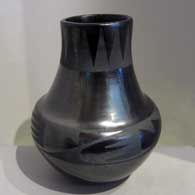
Maximiliana Montoya
San Ildefonso
Maximiliana Montoya (1885-1955), better known as Anna, was the eldest sister of Maria Martinez. Like Maria, Anna was making beautiful polychrome pottery in the early 1900s. However, Maria almost never painted anything so Anna painted for her until Maria married Julian and he took over the painting. When Maria and Julian started making black-on-black pottery, Anna was one of the early learners and adopters of the technique.
Anna's husband was Crescencio Martinez, one of the founders of the San Ildefonso School of watercolor artists. He painted many pieces for Anna and they were encouraged and supported by Dr. Edgar L. Hewett almost as much as he encouraged and supported Maria and Julian. After Crescencio passed away in the flu epidemic of 1918, Anna painted all her own pieces and soon became an accomplished painter in her own right.
Anna worked with Maria for many years, sometimes polishing pots, sometimes decorating them. Maria often commented on how "everyone bothered" Anna to "put design" on their pottery. Anna also developed her own distinctive forms and shapes, including an elegant "teardrop."
100 West San Francisco Street, Santa Fe, New Mexico 87501
(505) 986-1234 - www.andreafisherpottery.com - All Rights Reserved

San Ildefonso Pueblo
San Ildefonso Pueblo is located about twenty miles northwest of Santa Fe, New Mexico, mostly on the eastern bank of the Rio Grande. Although their ancestry has been traced to prehistoric pueblos in the Mesa Verde area, their most recent ancestral home is in the area of Bandelier National Monument, the prehistoric village of Tsankawi in particular. Tsankawi abuts the reservation on its northwest side.
A mission church was built in 1617 and named for San Ildefonso. Hence the name. Before that the village was called Powhoge, "where the water cuts through" (in Tewa). Today's pueblo was established as long ago as the 1300s. When the Spanish arrived in 1540, they estimated the village population at about 2,000.
That mission was destroyed during the Pueblo Revolt of 1680 and when Don Diego de Vargas returned to reclaim the San Ildefonso area in 1694, he found virtually all the Tewa people on top of nearby Black Mesa. After an extended siege the two sides negotiated a treaty and the people returned to their villages. However, the next 250 years were not good for them. The Spanish swine flu pandemic of 1918 reduced the pueblo's population to about 90. Their population has grown to more than 600 now but the only economic activity available on the pueblo involves creating art in one form or another. The only other work is off-pueblo. San Ildefonso's population is small compared to neighboring Santa Clara Pueblo, but the pueblo maintains its own religious traditions and ceremonial feast days.
San Ildefonso is most known for being the home of the most famous Pueblo Indian potter, Maria Martinez. Many other excellent potters from this pueblo have produced quality pottery, too, among them: Blue Corn, Tonita and Juan Roybal, Dora Tse Pe and Rose Gonzales. Of course the descendants of Maria Martinez are still important pillars of San Ildefonso's pottery tradition. Maria's influence reached far and wide, so far and wide that even Juan Quezada of the Mata Ortiz pottery renaissance in Chihuahua, Mexico, came to San Ildefonso to learn from her.
100 West San Francisco Street, Santa Fe, New Mexico 87501
(505) 986-1234 - www.andreafisherpottery.com - All Rights Reserved

